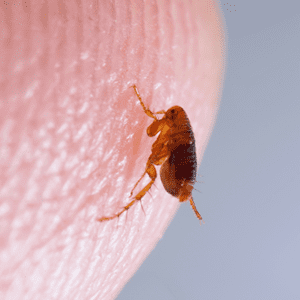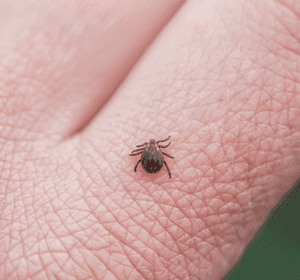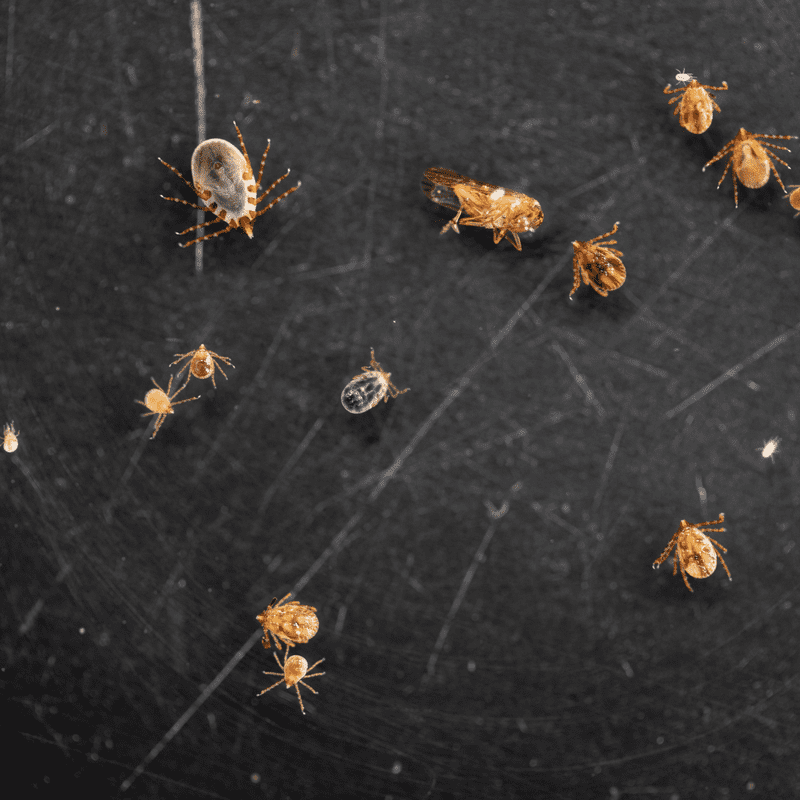You may think your family and pets are safe from the harmful bites of fleas and ticks as long as they stay in your backyard. Unfortunately, this isn’t a guarantee. Fleas and ticks are opportunists that will jump – pun intended – at any chance to hitchhike on us or our pets. By following these flea and tick control best practices, you can keep your family safe during Michigan’s flea and tick season.
Summary Points
ToggleKeeping Pets Safe From Fleas And Ticks
How To Identify Fleas And Ticks
Due to their small size and similar coloring, it can be challenging to tell the difference between fleas and ticks. Here’s how to tell them apart.
Fleas
Fleas are the smaller of the two. They are reddish-brown in color and have shiny exoskeletons. At only about 2.5 mm in length, fleas can be tough to spot, especially if your pet has dark-colored hair. They don’t have wings, but they make up for that by being incredibly good at jumping. They can jump as high as eight inches – that’s about 150x their own body height. Pretty remarkable! That’s why it’s so important to get flea control every year. They will quickly infest areas where your dog or cat likes to nap. They bite both pets and humans alike, but they do not live on humans, unlike other pests like ticks. Most of the time, fleas are brought in when our pets carry them in from outside. Their bites leave behind red, swollen, itchy bumps. In severe cases, your pet may experience an allergic reaction.
Ticks
Ticks are not as ambitious as fleas. Fleas will use their jumping abilities to hop onto your pet as it passes by. Ticks can’t jump well. They prefer to hide in places like tall grass, where they can cling to leaves and stems and wait for an animal or human to brush against them. When this happens, they will latch onto the victim. And unlike fleas, they can live on humans until they are removed or full of blood. They appear brown, red-brown, yellow, or black. Some are roughly the same size as fleas but most a few millimeters larger – especially if they are engorged with blood.
Diseases Carried By Fleas And Ticks
At best, if a flea or tick bites you or your pet, you’ll get an extremely itchy bump that goes away in a few days. At worst, you or your pet could end up with something far worse, like Lyme disease, Rocky Mountain spotted fever, Equine Encephalitis, tapeworm, and more. Some people can even develop allergies to eating red meat after being bitten by ticks.
How To Get Rid Of Fleas And Ticks
The best and most effective prevention method is hiring a pest control company. Top Lawn offers a flea and tick control application for your outdoor space to treat the root of the problem by killing off the bugs – not just repelling them. In addition to a professional application, there are other things you can do to keep you and your pets safe.
Don’t Neglect The Mowing Schedule
Like many pests, fleas and ticks thrive in taller grass. Keeping your grass mowed regularly, so fleas and ticks won’t be tempted to enter your yard.
Don’t Provide Sources Of Water, Food, and Shelter
If fleas and ticks can’t find water or shelter, they certainly won’t stick around hoping for a food source. Here are some things you can do to keep your pets protected going forward.
- Don’t let your pets romp through tall ornamental grasses
- Seal off the underside of porches and decks so your pets can’t crawl beneath them
- Avoid overwatering your lawn – this can invite not only fleas and ticks but also mosquitoes
- Don’t let leaves, twigs, grass clippings, or other organic matter pile up on your lawn
Inspect Your Pets After They’ve Been Outdoors
A few passes with a flea comb will pull out any bugs that may have hitched a ride. Also, fleas and ticks on dogs could be lurking in between the pads on their paws, so don’t forget to inspect their feet!
Put Up A Privacy Fence
If your property is directly next to a wooded or swampy area, consider putting up a privacy fence. This physical barrier will slow the migration of any fleas or ticks and will keep pets from the temptation of running off into the woods. Also, if you have a treehouse, playscape, deck, porch, patio, or other hardscaping feature, move it away from the wooded areas of your property. Or, if you’re considering adding a hardscaping feature to your yard, consider putting it closer to the middle of your property, away from the woods. This will decrease the likelihood that pests will invade the structure. If your hardscaping cannot be easily relocated, don’t worry. Top Lawn will identify all the common hotspots for flea and tick activity and treat them accordingly.
Hire Pest Control Services Near Canton, MI
For 20 years, the experts at Top Lawn have protected thousands of homes from the painful, dangerous bites of fleas and ticks. Our summer insect control program rids your property of fleas, ticks, and other annoying bugs all season long! We time our applications, so there’s never a gap in coverage. To learn more or schedule an appointment, give us a call at (248) 956-6022 or drop us a message online. We’re happy to discuss your needs and answer any questions.
To learn more about other lawn care service topics like caring for your grass, keeping your trees and shrubs happy, or the benefits of organic lawn care, be sure to check out our blog page. We’re also active on Facebook and Twitter! Follow us for more tips and be alerted to special deals!





